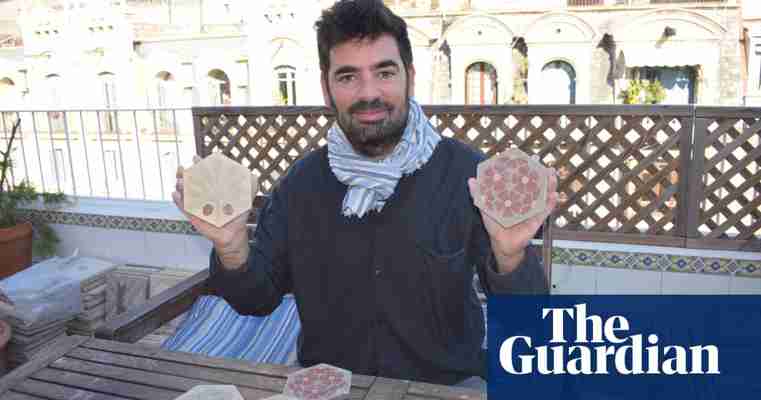Each morning, from the moment when Joan Moliner unfolds his bicycle for the ride to work to Barcelona city centre, he is on a mission, one eye on the road, the other on builders’ skips. His quarry, if that’s the word, is cement floor tiles.

All over the city, 19th-century apartment blocks are being made over into luxury flats. In the process, a vital part of Barcelona’s heritage – its decorative tiled floors – is ending up in a dump.
Conservation of the architectural heritage rarely extends beyond listing the facade, despite the wealth of interior detail in buildings erected at a time when Barcelona was a mecca for artists and artisans.
“I see these old buildings as a conversation between all the different parts – the walls, the floors, all the details,” says Moliner. “Preserving the facade and nothing else doesn’t make much sense. It’s part of our evolution as a society that we’re throwing away.”
A tile display with Moliner’s Brompton bicycle. Photograph: Joan Moliner
Moliner, who when he gets off his bike at the end of his commute works as an employment adviser, picked up his first tile seven years ago. Stirred by the memory of the tiled floors in his parents’ house, he started collecting manufacturers’ catalogues and researching the history.
Every tile tells a story, he says, surveying the 1,600 of them stacked up on his terrace.
One such story is Antoni Gaudí’s Panot, a hexagonal tile featuring marine creatures manufactured by Escofet, Barcelona’s biggest tile company. It was originally intended for his Casa Batlló, but was eventually used on the floor of the Casa Milà on the nearby Passeig de Gràcia. In 1997, as a tribute to its most famous architect, the city relaid the elegant boulevard’s pavement with a reproduction of the Panot.
The tiles Moliner collects came about thanks to the creation of cheap and versatile portland cement in the early 19th century by the Englishman Joseph Aspdin and were used to floor most of the buildings constructed in Barcelona from 1870 to 1950. Easier to lay, they did not need to be fired and could be produced by hand by a team of four artisans working a hydraulic press.
Furthermore, they could be printed with any pattern, freeing artists from the rectilinear restraints of mosaic to produce the images of flora and fauna that are a trademark of modernisme, the distinctly Catalan version of art nouveau. “Escofet was one of the first manufacturers to employ artists to design the tiles,” says Moliner.
A post on the Rajoles de Barcelona Instagram feed. Photograph: Rajoles de Barcelona
The advent of the hydraulic cement tile coincided with a massive building boom in Barcelona, when it broke out of the confines of the medieval city to create the grid-like Eixample (Extension), where the Catalan bourgeoisie flaunted wealth that was often made off the back of slave labour in the textile and sugar industries.
Moliner believes it’s important to conserve this part of the city’s heritage, even if the tiles can’t remain in situ. “There’s been talk for a long time about putting them in a museum, but nothing’s come of it so far.”
He says he’s not interested in making money from his passion. However, he is hoping to collaborate with a centre for disabled people where they could refurbish, frame and perhaps sell the tiles.
Allow Instagram content? This article includes content provided by Instagram . We ask for your permission before anything is loaded, as they may be using cookies and other technologies. To view this content, click 'Allow and continue'. Allow and continue
Meanwhile, he uses an app to recreate entire floor patterns based on the tiles he finds matched to catalogues and then puts them on Instagram at rajolesdebarcelona.
“I got around 3,000 likes almost overnight so obviously it’s not just me who finds this interesting.
“What I like is that it’s all handmade,” he says. “The tiles are handmade, they were laid by hand and then someone digs them up by hand and throws them out and I clean them by hand. I feel this connection with over a century of manual labour.”








